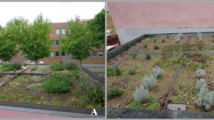Abstract
Nowadays, integrating moss among decorative plants in urban landscape architecture can be an important alternative to horticulture. Especially using moss design for covering roofs and walls it could be an interesting element to improve the life/-airquality. Introducing moss design using hydroponic systems requires finding the best technologies for cultivating the species that can be used by landscape architecture. The study has been performed at the University of Applied Science Osnabrueck, Germany, in 2015 and it consisted in testing several species of common moss in what concerns their behavior to environmental conditions controlled in the greenhouse, with the scope of hydroponic growing. 6 species of moss: Totula ruralis Hedw., Camptothecium sericeum Hedw, Ceratodon purpureus Hedw., Grimmia pulvinata Hedw, Racomitrium aciculare Hedw. and Bryum capillare Hedw., have been transplanted from a natural habitat to the greenhouse and their behavior to different water dosing and light intensity was checked. After the observations made using the principle of rating, it was concluded that the species Grimmia pulvinata and Ceratodon purpureus adapted the best to the controlled environment and this quality makes them suitable to be used in landscape design.
Zusammenfassung
Heutzutage können Moose in der städtischen Landschaftsarchitektur eine wichtige Alternative zum herkömmlichen Gartenbau sein. Hier sind vor Allem der Einsatz von Moosen zur Dach- und Wandbegrünung im innerstädtischen Raum zu benennen, da diese sowohl als Designelement als auch zur Verbesserung der Luft- und Lebensqualität beitragen können. Zur Einführung von Moos-Hydrokultur-Systemen ist es zunächst erforderlich die besten Technologien für die Kultivierung dieser Pflanzen zu charakterisieren. Eine erste Studie zum Einsatz von Moosen wurde im Jahr 2015 an der Hochschule Osnabrück, Deutschland, durchgeführt. Ziel war hierbei zunächst die Prüfung mehrerer Moosarten in Bezug auf ihr Verhalten gegenüber verschiedenen Bewässerungsintensitäten unter gleichbleibenden Gewächshausbedingungen. Getestet wurden 6 Moosarten: Totula ruralis Hedw., Camptothecium sericeum Hedw., Ceratodon purpureus Hedw., Grimmia pulvinata Hedw., Racomitrium aciculare Hedw. und Bryum Thermometer Hedw.. Die Pflanzen wurden vor dem Test aus ihrem natürlichen Lebensraum entnommen und in ein Gewächshaus überführt um dort ihr Verhalten unter 4 verschiedenen Bewässerungsdosierungen zu prüfen. Ein Boniturschlüssel diente zur Erfassung der Ergebnisse. Letztlich kann der Schluss gezogen werden, dass die Arten Grimmaia pulvinata und Ceratodon purpureus als die geeignetsten Arten für die Verwendung im innerstädtischen Raum in der Landschaftsarchitektur hervorgehen.







Similar content being viewed by others
References
Aichele D, Schegler HW (1984) Unser Moos und Farnpflanzen. p. 277. Franckh-Kosmos Verlag, Stuttgart
Atherton I, Bosanquet S, Lawley M (2010) Mosses and Liverworts of Britain and Irland a field guide. British Bryological Society, United Kingdom
Blanc P (2009) The Vertical Garden: From Nature to the City. W.W. Norton Company, Revised and Updated edition (April 23., 2012), New York
Boehm R, Krato T, Dohm A, Hendriks L (2011) Entwicklung von Screening-Verfahren zum Bewertung der Trockenstresstoleranz von Zierpflanzen. Julius-Kühn Archiv 0(433), 33. doi:10.5073/jka.2011.433.007
Chiaffredom M, Denayer F (2004) Mosses, A necessary step for perennial plant dynamics Proceedings Greening Rooftops for Sustainable Communities, Conference, Oregon, June 2–4 2004.
Dickson JH (1973) Bryophytes of the Pleistocenes. University Press, Cambridge
Dülln R, Düll-Wunder B (2008) Moose einfach und sicher bestimmen. Ed. Quell & Meyer, Wiebelsheim
Frahm J‑P (2006) Moose-Eine Einführung. Ed. Weissdorn, Jena
Frahm J‑P (2008) Mit Moosen begrünen. Ed. Weissdorn, Jena
Glime JM (2007a) Bryophyte Ecology vol. 5. Gardening: Private Moss, Technological University, Michigan
Glime JM (2007b) Bryophyte Ecology vol. 1. In: Light: effects of high intensity. Technological University, Michigan (Chapter 9-3)
Glime JM (2015) Bryophyte Ecology vol. 1. Water Relations: Leaf Strategies. In: Technological University, Michigan (Chapter 7‑4)
Jahns H (1995) BLV Bestimmungsbuch – Farne-Moose-Flechten. BLV, München
Hellbach M (2013) Die Verwendung von Moosen in der japanischen und eurpäischen Gartenkultur: Darstellung und Vergleich. Gartenkunst 25(2):377–400
Kelcey J‑G, Müller N (2011) Plants and Habitats of European Cities. Springer, New York
Li Y, Glime JM, Liao C (1992) Responses of two interacting Sphagnum species to water level. J Bryol 17:59–70
Phillips R (1980) Grasses, Ferns, Mosses & Lichens of Great Britain and Irland. Pan Books, London
Phillips R (1987) Das Kosmosbuch der Gräser, Farne, Moose, Flechten. Franckh-Kosmos Verlag, Stuttgart
Popescu G (2009) Introducere in botanica filogenetica. Ed. Sitech, Craiova
Radu DM, Trautz D, Cantor M (2015) Moss: Decorative and Ecological Potential in Landscape. ProEnvironment 8:80–84 (Cluj-Napoca)
Richardson DH (1981) The biology of mosses. Blackwell Scientific Publications, Oxford
Schenk G (2007) Moss Gardening. Timber Press, Oregon
Watson EV (1999) British Moss and Liverwort. University Press, Cambridge
Whitehouse HLK (1964) A flora of Cambridgeshire. University Press, Cambridge
Wood AJ, Duff RJ, Melvin JO (2000) The translational apparatus of Tortula ruralis: polysomal retention of transcripts encoding the ribosomal proteins RPS14, RPS16 and RPL23 in desiccated and rehydrated gametophytes. J Exp Bot 51(351):1655–1662
Zawadzińska A, Salachna P (2015) Growth, Flowering and Photosyntetic Pigments of Pelargonium x Hortorum LH Bailey ‘Survivor Hot Pink’ and ‘Graffiti Fire’ Grown in Substrates Containing Sewage Sludge Compost. J Ecol Eng 16(3):168–176. doi:10.12911/22998993/2951
Acknowledgements
The work of this paper was sustained by DBU (German Federation of Environment) during a practical experiment at University of Applied Science, Hochschule Osnabrueck, Faculty of Agricultural Science and Landscape Architecture.
Author information
Authors and Affiliations
Corresponding author
Rights and permissions
About this article
Cite this article
Radu, D.M., Kohlbrecher, M., Cantor, M. et al. Response of some moss species to different controlled environmental conditions in order to use in Landscaping. Gesunde Pflanzen 68, 109–115 (2016). https://doi.org/10.1007/s10343-016-0365-5
Received:
Accepted:
Published:
Issue Date:
DOI: https://doi.org/10.1007/s10343-016-0365-5




